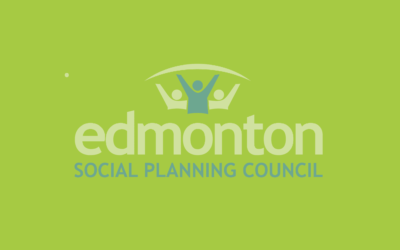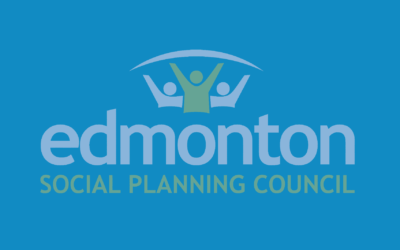Blog: Get Your House in Order: Canada Marks National Housing Day, November 22

Written by Carrie-Anne Cyre, ESPC Volunteer
November 22, 2023, commemorates Canadian National Housing Day, a day for Canadians to recognize housing as a fundamental human right. Established in 2019, the Canadian Parliament passed the National Housing Strategy Act. This Act acknowledged housing as a human right, compelling governments, and organizations to revamp housing laws, policies, and programs. It also emphasized a rights-based approach and highlighted the importance of community involvement in solving the housing crisis (1). While Canada may recognize housing as a human right, the reality is that increasing numbers of Canadians are having trouble accessing adequate and safe housing. Across Canada, many advocacy and health groups have increasingly sounded the alarm regarding the growing unaffordability of the cost of living in Canada, especially housing, which has become an increasingly urgent problem in urban centers. Indeed, the cost of housing is becoming increasingly difficult not only for low-income- Canadians, but for moderate-income households, individuals on fixed incomes such as Canadian social services, persons with disabilities, visible minorities, and Indigenous persons (2)
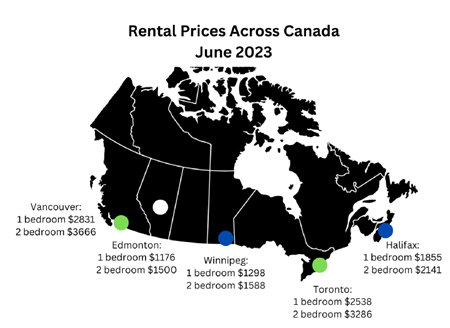

Why is housing so expensive in Canada? The short answer is that Canadian housing is in short supply and experiencing high demand. While Canada has a low population, the nation has experienced the highest population growth among the G7 nations over the last decade. The Group of Seven, or G7, is an informal group used for comparing seven of the world’s more advanced economies: Canada, the European Union, France, Germany, Italy, Japan, the United Kingdom, and the United States (5).
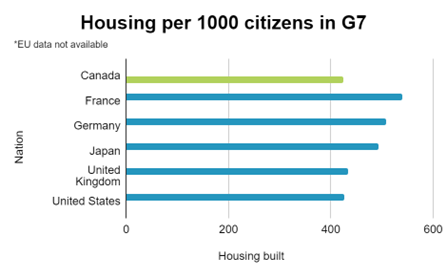
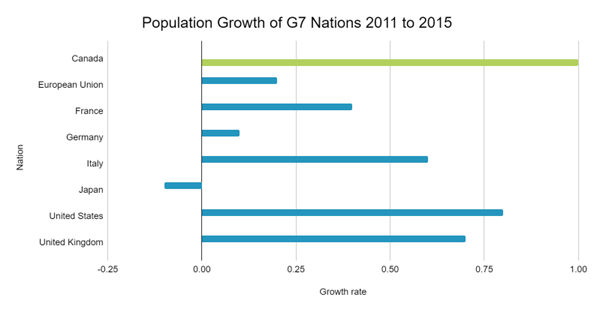
Population density is also a concern in Canada. Despite being the world’s second-largest country, covering over 9,984,670 km² with a slightly more than 40 million population, Canada maintains a low average population density of 4.2 individuals per square kilometre. Approximately two-thirds of Canadians reside within 100 km of the Canada-US southern border, primarily in the major cities of Vancouver, Toronto, Ottawa, Montreal, and Quebec City. Although these densely populated regions cover only 4% of Canada’s territory, they accommodate close to 80% of the population (8). Notably, cities like Toronto and Vancouver exhibit lower population densities than their European or American counterparts. Vancouver, the most densely populated city in the nation, has about 18,837 inhabitants per square kilometre, about half that of Manhattan (9).
Despite the growing population and low population density, Canadian politicians have only recently begun to address the consequences of decades of political and economic factors that have restricted housing development in Canada (10). Notably, during the 1980s and 1990s, as the Canadian government adopted increasingly neoliberal socio-economic policies, all federal funding for social housing was halted in 1993 (11). The repercussions of these spending cuts were substantial, leading to a significant reduction in construction of low or affordable housing units across the nation and the scaling back of various other Canadian social safety nets that also contributed to affordability (12). This combination of social austerity and the absence of adequate building incentives has contributed to the rapidly developing crisis of poverty and homelessness that Canada finds itself in today.
The housing situation in Canada has even worsened over recent decades due to a lack of prioritization of housing construction in federal policy. A combination of additional factors affecting housing construction and prices—including increasing urbanization, internal migration, immigration, foreign investments, short-term rentals, stagnant wages, resource costs, global conflicts, the COVID-19 pandemic, and inflation rates—has intensified pressure on existing housing (13). Canadians, especially in cities like Toronto and Vancouver, face significant challenges in accessing affordable housing.
Despite acknowledging housing as a human right every November 22, Canadian housing policy has focused on relying on market forces and incentives to fulfill this commitment. The substantial surge in rental and purchase prices in recent years has further led to a marked increase in homelessness. Estimating the number of people experiencing homelessness in Canada is challenging. Statistics Canada reported an estimated 235,000 people who were unhoused in 2021(14). Still, this count is definitely an underestimate as it does not count hidden homelessness (individuals who are staying with friends or family), individuals at risk of homelessness nor people living in unsafe conditions (15). Even without exact numbers, it is clear that the population without secure, stable housing has reached unprecedented levels (16).
Past policies have proven ineffective as they relied on the market to determine housing availability (17). Additionally, there has been insufficient funding for social housing, and when funding is provided, it often lacks proper evaluative or accountability mechanisms. To rectify this issue, the Canadian government must urgently prioritize addressing this problem and allocate sufficient resources. Housing is expected to become a pivotal issue in the 2025 Federal election, and we will all be watching.
| It has been estimated that an additional 3.5 million affordable housing units would need to be constructed by 2030 to stabilize housing prices 18). |
1. NRHN. (2003). Right to Housing. Retrieved from https://housingrights.ca/right-to-housing-legislation-in-canada/.
2. Canadian Human Rights Commission. (2023). Unaffordability and lack of housing among top systemic issues reported across Canada. https://www.housingchrc.ca/en/unaffordability-and-lack-of-housing
3. Rentals.ca. (2023). Rentals.ca June 2023 Rent Report. https://rentals.ca/blog/rentals-ca-june-2023-rent-report.
4. Canadian Real Estate Association. (2023). National Statistics. Canadian Home Sales See Downward Trend Continue in October. https://stats.crea.ca/en-CA/
5. Government of Canada. (2023). Canada and the G7. https://www.international.gc.ca/world-monde/international_relations-relations_internationales/g7/index.aspx?lang=eng
6. Hajnal, P. (2022). Whither the G7 and G20?, Canadian Foreign Policy Journal, 28:2, 127-143, DOI: 10.1080/11926422.2022.2027797
7. Statistics Canada. (2022). Canada tops G7 growth despite COVID. https://www150.statcan.gc.ca/n1/daily-quotidien/220209/dq220209a-eng.htm
8. Statistics Canada (2022). Canada’s large urban centres continue to grow and spread. https://www150.statcan.gc.ca/n1/daily-quotidien/220209/dq220209b-eng.htm
9. Statistics Canada. (2021). Focus on Geography Series, 2021 Census of Population Canada. https://www12.statcan.gc.ca/census-recensement/2021/as-sa/fogs-spg/page.cfm?lang=E&topic=1&dguid=2021A000011124
10. Perrault, J-F. (2022). Which Province Has the Largest Structural Housing Deficit? Social Bank. https://www.scotiabank.com/ca/en/about/economics/economics-publications/post.other-publications.housing.housing-note.housing-note–january-12-2022-.html
11. Pablo, C. (2022).City and Culture: Vancouver tops list of Canada’s most densely populated downtowns. Georgia Straight. https://www.straight.com/news/vancouver-tops-list-of-canadas-most-densely-populated-downtowns
12. Osberg, L. (2021). From Keynesian Consensus to Neo-Liberalism to the Green New Deal: 75 years of income inequality in Canada. Canadian Centre for Policy Alternatives. https://policyalternatives.ca/publications/reports/75-years-of-income-inequality-canada
13. Rozworski, M. (2019, June 14). The roots of our housing crisis: Austerity, debt and extreme speculation. Retrieved from https://www.policynote.ca/the-roots-of-our-housing-crisis-austerity-debt-and-extreme-speculation/
14. Osberg, L. (2021). From Keynesian Consensus to Neo-Liberalism to the Green New Deal 75 years of income inequality in Canada. Canadian Centre for Policy Alternatives. Retrieved from https://policyalternatives.ca/sites/default/files/uploads/publications/National%20Office/2021/03/75%20Years%20of%20Income%20Inequality%20in%20Canada.pdf
15. Statistics Canada. (2021). Health Reports: Characterizing people experiencing homelessness and trends in homelessness using population-level emergency department visit data in Ontario, Canada. https://www.doi.org/10.25318/82-003-x202100100002-eng
16. Homeless Hub. (2021). How many people are homeless in Canada? https://www.homelesshub.ca/about-homelessness/homelessness-101/how-many-people-are-homeless-canada.
17. Canadian Human Rights Commission. (2023). Unaffordability and lack of housing among top systemic issues reported across Canada.
18. CMHC. (2023). Estimating how much housing we’ll need by 2030. Retrieved from https://www.cmhc-schl.gc.ca/blog/2023/estimating-how-much-housing-we-need-by-2030


